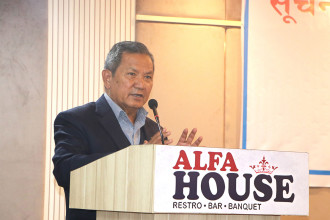KATHMANDU: Community Homestay Network (CHN) organised an event called 'Community Connect' from May 16 to 26, 2024. The event hosted 30 international delegates to experience Nepal's unique travel offerings.
The event was a collaboration between Nepal Tourism Board (NTB), USAID Trade and Competitiveness, and HI-GRID, a project supported by the Australian Government and implemented by the International Centre for Integrated Mountain Development (ICIMOD) and its partners.
The international participants included journalists, photographers, media personalities, advocates of sustainable and community tourism, B2B travel companies, and local Destination Management Companies (DMCs).
The event concluded with four immersive exposure trips in various parts of Nepal, followed by a final event on May 26 in Kathmandu. The aim was to empower local communities, promote responsible tourism practices, and encourage the preservation of natural and cultural heritage. Participants were grouped into four different exposure trips based on their interests and expertise in community-based tourism.
-1716874178.jpg)
After the exposure trips, the final event on May 26, 2024, at Hotel Shanker in Kathmandu, was organised in collaboration with the NTB. It brought together around 200 participants from local communities and other stakeholders. The event showcased CHN's values centred on community-based tourism. Through these initiatives, CHN aims to raise global awareness of community-based tourism products and inspire travellers with compelling narratives. The media content generated from the exposure trips is invaluable in promoting the authentic cultural elements and unique experiences of these emerging destinations in Nepal.
-1716874280.jpg)
-1716874280.jpg)
-1716874250.jpg)
The exposure trips:
Trip 1: Kathmandu: Beyond the Ordinary (May 18-24, 2024)
Participants explored Kathmandu's culture and nature, connecting with local communities. They stayed at the Nagarkot Community Homestay, practised Hatha yoga, and hiked to the Jalpa Devi Temple.
A hike from Nagarkot to Nala led them to Namobuddha, followed by a bike ride to Panauti, where they visited pilgrimage sites. At the Panauti Community Homestay, they dressed in local attire and cooked Newari food.
On their return to Kathmandu, they stopped in Kirtipur to learn the Ranjana Lipi script, enjoy Newari cuisine, and explore the town.
The tour offered an understanding of Nepalese life and culture. Local community members in Thimi and Kirtipur welcomed the participants to experience traditional crafts.
Trip 2: The Traces of Terai and its Tharu Heritage (May16-24, 2024)
Participants immersed themselves in the Tharu culture of Western Nepal, known for its stick dances and cuisine.
At Bhada Community Homestay, they explored the Bheda Baba Temple, Ghoda Ghodi Lake, and enjoyed Tharu dance performances.
In Bardiya National Park, they experienced wildlife through jeep safaris and bird watching, learning about the locals' symbiotic relationship with nature. The youth leaders of Shiva Community forests explained their efforts to conserve the forests and combat poaching.
On Buddha Jayanti, participants visited Lumbini, the birthplace of Lord Buddha, and explored nearby monuments before travelling to Barauli. At Barauli Community Homestay, they explored the village and enjoyed sunsets by the river.
Throughout the trip, they observed the traditions of the Tharu communities, gaining an understanding of their culture and lifestyle.
Trip 3: Annapurna Community Trek (May 16-24, 2024)
Participants enjoyed a journey on the Annapurna Community Trek, experiencing village life in the Himalayan region.
At Mohare Hill (3,300m), they saw panoramic views of peaks like Annapurnas, Dhaulagiri, and Machhapuchchhre. The trek offered interactions with local farmers, yak herders, and villagers. In Narchyang Community Homestay, trekkers cooked with their hosts, fostering cultural exchange. The conventional tourism model in Nepal focuses on popular destinations, such as Tatopani on the Annapurna Circuit Trail.
By developing alternative destinations like Narchyang, offered by CHN since 2019, travellers can enjoy a community-based experience.
The trek showcased the Himalayas, terraced farmlands, and rhododendron forests, immersing travellers in the culture and traditions of local ethnic groups.
Trip 4: The Roads Less Taken (May 17-24, 2024)
Participants enjoyed the natural beauty and cultural experiences of Eastern Nepal.
In Dhankuta, they appreciated the local beauty, took part in a cultural walk led by the youth group Kopche Punar Jagaran Aviyan, and experienced Aathpahariya culture at Dhankuta's first community homestays. Dhankuta faces challenges from climate change and economic stagnation, impacting agriculture and the livelihoods of marginal groups like the indigenous Aathpahariya. ICIMOD’s HI-GRID project, in collaboration with local bodies, addresses these issues through a responsible tourism pilot project.
The project promotes tourism development through activities including community homestays, farm stays, experiential tourism, water resource protection, sustainable farming, cultural heritage, and waste management.
The project aims to create economic opportunities and improve the lives of women and marginalized communities. Participants appreciated the Aathpahariya community's culture and tradition, as well as the climate-resilient solutions and responsible tourism products and experiences.
In Janakpur, they visited the Janaki Mandir and participated in a Mithila Art session with Mithila Naari Hastakala, a local initiative promoting women's empowerment and Mithila culture.
The Panauti Community Homestay offered an immersive experience in women-led empowerment and Newari culture. A stop in Kirtipur allowed participants to discover historical sites, learn the Ranjana Lipi script, and enjoy traditional Newari cuisine.
READ ALSO:
- Nepal’s CHN wins ‘Front Runners 2021 Travel Tech Competition’ at WTM London summit
- CHN reconnecting with local communities for tourism recovery
- Advancing responsible tourism: Shiva Dhakal
- Building Sustainability In Education Programs for Children In Need





-1745575590.jpeg)